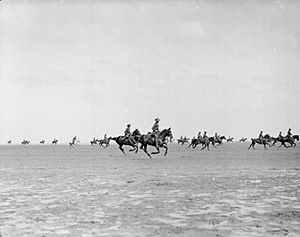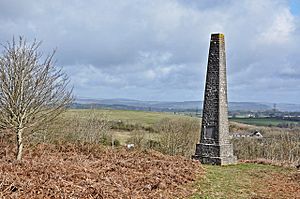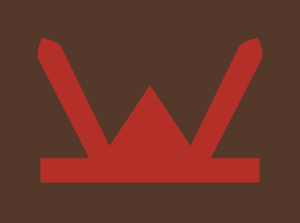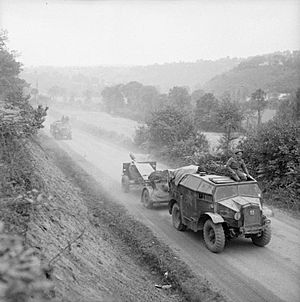Glamorgan Yeomanry facts for kids
Quick facts for kids Glamorgan Yeomanry |
|
|---|---|

Glamorgan Yeomanry cap badge
|
|
| Active | 1797–1831 1861–1873 (Light Horse Volunteers) 1901–present |
| Country | |
| Branch | |
| Type | Yeomanry |
| Size | Regiment |
| Engagements |
|
| Commanders | |
| Notable commanders |
Col Windham Wyndham-Quin |
The Glamorgan Yeomanry was a special cavalry unit from Wales. It was part of the British Army. This group was first formed in the late 1700s. People were worried about a possible invasion by the French at that time.
The Yeomanry helped keep order in South Wales in the early 1800s. It was then stopped in 1831. The unit was started again during the Second Boer War. It later served in World War I and World War II. During World War II, they fought as an artillery unit. Today, a troop called C (Glamorgan Yeomanry) Troop keeps its history alive. This troop is part of the 211 (South Wales) Battery, 104th Regiment Royal Artillery.
Contents
- Early Days: French Wars and Keeping Order
- 19th Century: Keeping the Peace in Glamorgan
- Light Horse Volunteers
- Imperial Yeomanry: The Second Boer War
- Territorial Force: Before World War I
- World War I: Fighting Overseas
- Between the World Wars
- World War II: Fighting as Artillery
- After World War II
- History and Traditions
- See also
Early Days: French Wars and Keeping Order
When Britain was fighting in the French Revolutionary Wars, the Prime Minister, William Pitt the Younger, had an idea. In 1794, he suggested that counties should create groups of Volunteers. These groups would help defend the country from invaders. They could also help local leaders stop any trouble.
The government especially liked cavalry units made of landowners and farmers. These units were called Yeomanry. They were good because they could move quickly. Also, their members were seen as very loyal. By the end of 1794, 27 counties had Yeomanry units. But Glamorgan was a bit slow.
Then, in February 1797, the French tried to land in South Wales. This event, known as the Battle of Fishguard, made people in Glamorgan act fast. More Yeomanry units were quickly formed:
- The Neath Troop was started in May 1797.
- The Swansea Troop was formed in May 1797.
- The Cardiff Troop began in June 1798.
- The Fairwood Troop from the Gower Peninsula was also raised in June 1798.
In April 1800, the Swansea Troop helped stop corn riots in Neath and Swansea. Their arrival was enough to make the rioters leave. There was more trouble in Merthyr Tydfil. The Cardiff Troop helped arrest 50 rioters there. They used the flat side of their swords, so no one was killed.
In July 1800, the Swansea Troop joined with other local volunteer groups. They formed the Swansea Legion. The war seemed to end in 1802 with the Treaty of Amiens. Many volunteer groups were stood down. The Neath Troop disbanded, but the Swansea, Cardiff, and Fairwood troops continued.
When the war started again in 1803, these three Yeomanry units kept serving. Over the years, they trained regularly. In 1813, smaller Yeomanry groups were encouraged to join together. The Swansea, Fairwood, and Cardiff Troops combined. They formed the Glamorgan Yeomanry Cavalry.
19th Century: Keeping the Peace in Glamorgan
After the Battle of Waterloo in 1815, many volunteer forces were stood down. But the Yeomanry continued. They were still used to help local authorities keep order.
In October 1816, there were strikes at ironworks in South Wales. Violence broke out at the Dowlais Ironworks. The Cardiff Troop and a part of the Swansea & Fairwood Cavalry arrived. They helped stop the trouble. They used the flat of their swords to disperse a large crowd. About 30 people were arrested without anyone being seriously hurt.
The Home Secretary, Viscount Sidmouth, praised the Glamorgan Yeomanry for their actions. But he also said the force was too small. The Lord Lieutenant of Glamorgan, the Marquess of Bute, wanted to create two new troops. These new troops were formed in central Glamorgan and at Llantrisant.
By 1824, the Glamorgan Yeomanry was organized into three main groups:
- Swansea & Fairwood Corps (3 Troops)
- Central Glamorgan & Llantrisant Corps (3 Troops)
- Cardiff Troop
In December 1824, some troops helped prevent looting from a shipwreck. In May 1825, their presence alone was enough to stop trouble in Bridgend.
The Merthyr Rising
A serious riot, known as the Merthyr Rising, happened in June 1831. It started in Aberdare and spread to Merthyr. All iron production stopped. Local officials asked for military help. On June 3, soldiers from the 93rd Highlanders arrived. Rioters tried to disarm them, and the soldiers had to open fire. Many people were hurt or killed.
The three groups of the Glamorgan Yeomanry were called to Merthyr. On June 4, one troop tried to bring ammunition wagons. They were attacked by rioters but managed to get through. Another group was ambushed and disarmed.
On June 6, a large crowd of rioters approached. Lieutenant-Colonel Thomas Morgan ordered his troops to prepare. When the rioters ignored warnings, the soldiers loaded their weapons. The Yeomanry drew their swords. Seeing this, the rioters backed down. The Yeomanry then dispersed them without further injuries. Regular cavalry arrived on June 7. The Glamorgan Yeomanry returned home on June 10.
After these events, the government wanted to bring back the militia. The Marquess of Bute tried to reorganize the Glamorgan Yeomanry. But his plan didn't work, and the unit was disbanded in 1831. Glamorgan had no Yeomanry for many years after that.
Light Horse Volunteers
In 1859, there was another worry about invasion. This led to many part-time soldier units being created. One of these was the 1st Glamorgan Light Horse Volunteers. It was formed in Cardiff in February 1861. This unit was disbanded in 1873. For the rest of the 1800s, there were no Yeomanry or volunteer cavalry in Glamorgan.
Imperial Yeomanry: The Second Boer War
In December 1899, Britain faced difficulties in the Second Boer War. The government realized it needed more soldiers, especially mounted ones. On December 24, a special order created the Imperial Yeomanry (IY). These were volunteer units, usually about 115 men, who served for one year. They were equipped to fight on horseback. Many volunteers joined quickly, even if their riding or shooting skills weren't perfect.
One of the first IY units was 4th (Glamorgan) Company. It was formed by Windham Wyndham-Quin. He was a Member of Parliament and a retired major. His efforts were supported by the Western Mail newspaper. The men were chosen from over 300 applicants. They trained briefly and then sailed to Cape Town in February 1900.
The 4th (Glamorgan) Company arrived in Cape Town in March. They joined the 1st Battalion, IY. After more training, they moved to Bloemfontein. They helped prevent Boer fighters from re-entering the south-eastern Orange Free State. In July 1900, the 4th (Glamorgan) Company was present when a large Boer force surrendered. The company did many patrols and skirmishes. At first, they were new to fighting, but they quickly improved. By October, they were doing well as the advance guard.
After their year of service, Major Wyndham-Quin received a special award for his bravery.
Glamorganshire Imperial Yeomanry is Formed
The Imperial Yeomanry idea was a success. So, new regiments were formed from soldiers who had returned from South Africa. The Glamorganshire Imperial Yeomanry was approved in June 1901. It was formed in August 1901. Many members of the 4th Company joined this new unit.
Under the command of Lt-Col Wyndham-Quin, the regiment included:
- Headquarters in Maesteg
- A Squadron in Swansea
- B Squadron in Bridgend
- C Squadron in Cardiff
- D Squadron in Pontypridd (added in 1902)
- A machine gun section
In 1904, the new regiment trained with the Pembroke Imperial Yeomanry. In 1906, all four Welsh IY regiments trained together in mid-Wales.
Territorial Force: Before World War I
In 1908, the Imperial Yeomanry became part of the new Territorial Force (TF). This was part of the Haldane Reforms. The Glamorgan Yeomanry was now a dragoon regiment. It joined the TF's South Wales Mounted Brigade (SWMB).
The regiment had squadrons in:
- Swansea (with smaller groups in Neath, Port Talbot, Reynoldston)
- Bridgend (with smaller groups in Maesteg, Cowbridge, Porthcawl)
- Cardiff
- Pontypridd (with smaller groups in Nelson, Llwynypia, Caerphilly, Mountain Ash, Aberdare, Merthyr Tydfil)
World War I: Fighting Overseas
Mobilisation for War
When World War I started on August 4, 1914, the Glamorgan Yeomanry was called into action. They joined the SWMB. The TF was originally for home defense. But on August 10, units were asked to volunteer for service overseas. The Glamorgan Yeomanry volunteered almost entirely.
To prepare for overseas service, new "2nd Line" units were created. These were duplicates of the original units. Later, a "3rd Line" was formed to train new soldiers.
1/1st Glamorgan Yeomanry
By late August 1914, the 1/1st Glamorgan Yeomanry joined the 1st Mounted Division. They trained in East Anglia, England. They also helped defend the East Coast from possible invasion. In November 1915, the 1/1st SWMB was dismounted, meaning they would fight on foot.
In March 1916, the 1/1st SWMB sailed to Egypt. They joined another brigade to form the 4th Dismounted Brigade. This brigade guarded Egypt's western and southern borders. They did not see much fighting there. Some soldiers from the Glamorgan Yeomanry volunteered to join the Imperial Camel Corps.
Becoming Infantry: 24th (Pembroke and Glamorgan Yeomanry) Battalion, Welsh Regiment
In early 1917, the army in Egypt needed more infantry soldiers. The dismounted Yeomanry brigades were moved east. In January 1917, the Yeomanry soldiers officially became infantry. Their brigade became the 231st Brigade. This brigade joined the 74th (Yeomanry) Division in March 1917.
Cavalry regiments were smaller than infantry battalions. So, the dismounted Yeomanry regiments were combined. On February 2, the 1/1st Glamorgan Yeomanry joined with the 1/1st Pembroke Yeomanry. They formed the 24th (Pembroke and Glamorgan Yeomanry) Battalion, Welsh Regiment.
As part of the 74th Yeomanry Division, the battalion fought in many important battles in Palestine. These included the Third Battle of Gaza, the Battle of Beersheba, and the capture of Jerusalem.
In May 1918, the division moved to the Western Front in France. The battalion took part in the Hundred Days Offensive. This included the Second Battle of Bapaume and the Battle of Épehy. The 24th Welch entered the town of Ath on November 11, 1918. This was just two and a half hours before the war ended.
The battalion was officially disbanded on July 5, 1919.
2/1st Glamorgan Yeomanry
The 2nd Line regiment was formed in September 1914. In January 1915, it joined the 2/1st South Wales Mounted Brigade. By July, they were in the Dorchester area. In September 1915, they moved to Suffolk.
In July 1916, many 2nd Line Yeomanry units in the UK were changed. Most became cyclists. So, the regiment became a cyclist unit. It was then combined with the 2/1st Pembroke Yeomanry to form the 2nd (Pembroke and Glamorgan) Yeomanry Cyclist Regiment.
The regiment became the 2/1st Glamorgan Yeomanry again in March 1917. It was disbanded in October 1918, just before the war ended.
3/1st Glamorgan Yeomanry
The 3rd Line regiment was formed in 1915. It was later disbanded around February 1917. Its soldiers either joined the 2nd Line or another battalion.
Between the World Wars
The Glamorgan Yeomanry was reformed in Bridgend in February 1920. However, the war showed that there were too many cavalry units. So, when the TF became the Territorial Army (TA), most Yeomanry regiments changed roles. Many became artillery units.
On November 1, 1920, the Glamorgan Yeomanry became an artillery unit. It was named 324 (Glamorgan) Battery. This battery was part of the 81st (Welsh) Brigade, Royal Field Artillery (RFA). In 1923, its name changed to 324 (Glamorgan Yeomanry) Battery. In 1924, the RFA became part of the Royal Artillery (RA).
World War II: Fighting as Artillery
Preparing for War
In 1938, the TA doubled in size. Existing units split to form duplicates. The 81st (Welsh) Field Regiment split into two regiments. The 324 (Glamorgan Yeomanry) Field Battery stayed with the 81st. This regiment joined the 53rd (Welsh) Infantry Division.
Parts of the 53rd (Welsh) Division went to Northern Ireland in 1939. The regiment joined them there in March 1940. They returned to Britain in April 1941. By then, their batteries had eight 25-pounder guns. These guns were pulled by special tractors. In 1942, the division trained for the Allied invasion of Normandy (Operation Overlord).
Fighting in North West Europe
The 53rd (Welsh) Division landed in Normandy after D-Day on June 27, 1944. They fought in the Second Battle of the Odon. In August, they helped close the Falaise Pocket. This trapped many German soldiers. By late August, they had crossed the Seine River and were moving quickly.
The division also played a role in Operation Market Garden. They protected the side of another main attack. There was tough fighting near Eindhoven. The regiment fired many barrages. The 324 Battery directly supported infantry attacks. During one fight, the battery commander's vehicle was hit. He was safe, but two men with him were killed.
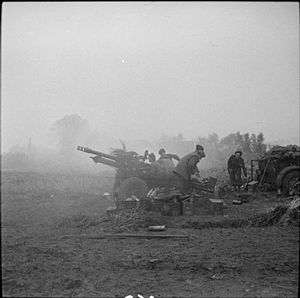
After Market Garden, the regiment moved to Nijmegen. In October, they advanced towards 's-Hertogenbosch. The attack began on October 22. The artillery fired to support the infantry. The town was captured after four days of street fighting.
Next, the 81st Field Regiment moved to Wessem. They helped cross the Wessem canal in November. They then moved towards Roermond. They supported an attempt to cross the River Maas. The artillery helped suppress German guns.
Fighting stopped due to winter weather. In December, some men from the regiment were moved to infantry units. This was to replace soldiers lost in earlier battles. On January 20, 1945, the division prepared for a special operation.
This operation was the Battle of the Reichswald (Operation Veritable). It began on February 8 with a huge artillery barrage. The 81st Field Regiment supported the infantry. The terrain was very difficult and muddy. It was hard to move guns and vehicles. Goch fell on February 21.
The 53rd Division was not in the main crossing of the Rhine River in March. But they crossed on March 26. They then drove towards the Elbe River. The German surrender at Lüneburg Heath came on May 4. This ended the fighting on that front.
The 81st (Welsh) Field Regiment and its batteries were put on hold in 1946.
After World War II
The regiment was reformed in Port Talbot. It was named 281st (Welsh) Field Regiment. It was part of the 53rd (Welsh) Division.
The 281st (Welsh) Regiment still had a Glamorgan Yeomanry battery. In September 1953, the regiment was renamed 281st (Glamorgan Yeomanry) Field Regiment. In October 1956, it absorbed other Glamorgan artillery units.
In May 1961, it combined with two other regiments to form:
282nd (Glamorgan and Monmouthshire) Field Regiment, RA
- P (Glamorgan Yeomanry) Bty
- Q (Welsh) Bty
- R (1 Monmouth) Bty
Finally, in 1967, the combined regiment became 211 (South Wales) Battery, Royal Artillery. This battery is located in Newport. It includes:
- D (Monmouthshire) Troop
- E (Glamorgan Yeomanry) Troop in Cardiff
- F (Brecknockshire and Monmouthshire) Troop
In 1986, 211 Bty helped form a new battery. But this new battery was reabsorbed in 1992. The battery was then reduced to:
- C (Glamorgan Yeomanry) Troop in Cardiff
- D (Brecknockshire and Monmouthshire) Troop in Abertillery.
Today, 211 (South Wales) Bty continues in the 104th Regiment Royal Artillery (Volunteers). It is part of the Army Reserve. It is a support unit with the L118 light gun. It is based at Ty Llewellyn Army Reserve Centre in Cardiff.
History and Traditions
Uniforms and Badges
The early Yeomanry troops in Glamorgan wore red jackets and special helmets. The Cardiff Troop wore yellow-faced jackets with white cords. Their helmets had a leopardskin wrap and a white feather. By 1820, the uniform changed to a Light Dragoon style. This included a blue jacket and a tall hat called a Shako.
When the Glamorgan Imperial Yeomanry formed in 1901, they wore a khaki uniform. They had a Slouch hat with a white feather for parades.
Even though they were called a dragoon regiment, their uniform had lancer influences. Officers wore a blue jacket with white front and cuffs. They had a white sun helmet with a brass spike. Other ranks had a dark blue tunic with silver shoulder chains. They had a silver leek badge on their collar. All ranks wore a khaki service uniform introduced in 1902. Their collar badge was a Welsh dragon.
During World War I, the 1/1st Glamorgan Yeomanry changed their badges when they joined the 24th (P&GY) Bn Welsh Regiment. But the 2/1st and 3/1st units kept their Yeomanry badges.
Between 1920 and 1941, the 324 (Glamorgan Yeomanry) Bty continued to wear the Glamorgan Yeomanry's cap badge. Officers wore gilt Welsh leeks on their blue jackets. Other ranks wore Welsh Dragon badges. During and after World War II, all soldiers wore Royal Artillery badges. But after 1967, the Glamorgan Yeomanry Troop was allowed to wear their regimental collar badge again.
Standards
The special flags, called standards, of two early Yeomanry units have been saved. The Cardiff Troop's standard is gold. It has the words 'CARDIFF YEOMANRY CAVALRY' surrounded by roses and thistles. It also shows the White Horse of Hanover. This standard was used until 1831.
The Central Glamorgan Yeomanry's standard is buff-colored. It shows the Red dragon of Wales on a green background. It also has a Union wreath (including shamrock). This standard was likely given in 1820–1821. It was used until the unit was disbanded.
Battle Honours
The regiment received special awards called Battle honours for its service in World War I. These are listed below. Those in bold would have been written on the unit's standard:
|
|
The Royal Artillery does not usually receive battle honours. Their motto, Ubique ('Everywhere'), covers all their battles. So, no specific honours were given for World War II.
Honorary Colonel
Colonel Robert Windsor-Clive, 1st Earl of Plymouth, was named Honorary Colonel of the unit on August 3, 1901. He passed away in 1923.
Memorial
A memorial for the soldiers of the regiment who died in World War I was built. It is an obelisk at Stalling Down Common, near Cowbridge. The Earl of Plymouth unveiled it on November 2, 1922.
See also
- Imperial Yeomanry
- List of Yeomanry Regiments 1908
- Yeomanry
- Yeomanry order of precedence
- British yeomanry during the First World War
- Second line yeomanry regiments of the British Army
- List of British Army Yeomanry Regiments converted to Royal Artillery



